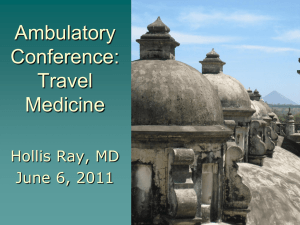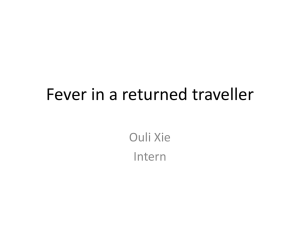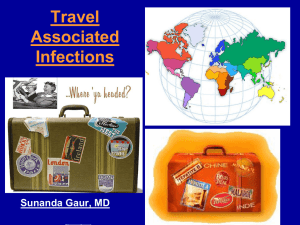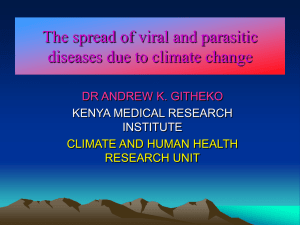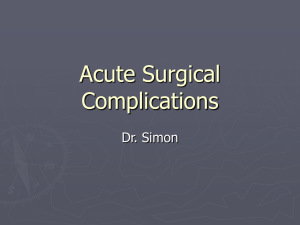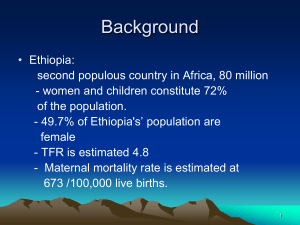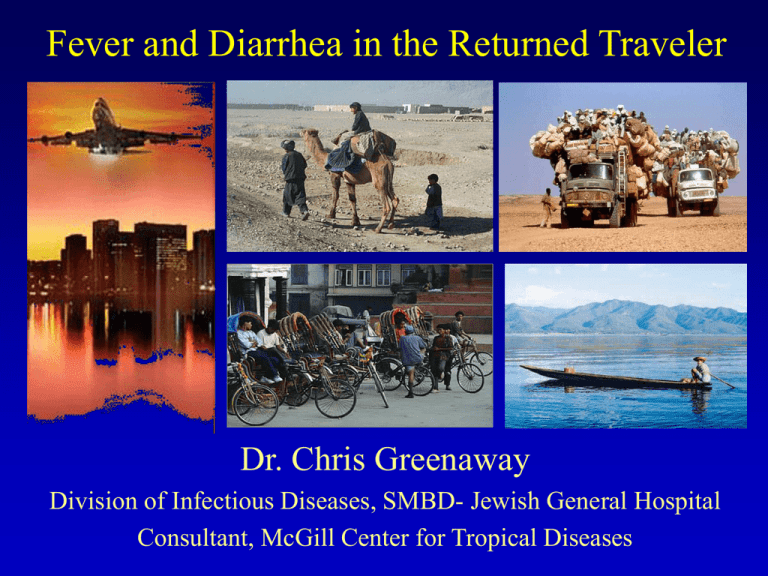
Fever and Diarrhea in the Returned Traveler
Dr. Chris Greenaway
Division of Infectious Diseases, SMBD- Jewish General Hospital
Consultant, McGill Center for Tropical Diseases
Case #1
• 46 year old Kenyan female presents to
your office with a 4 day history of high
fever 40C and cough
• 13 year old son has had a similar illness
for 6 days
• Physical exam is normal
• What do you want to know?
• What investigations do you want to do?
Case #1
•
•
•
•
Seen in a walk-in clinic
CXR- normal
Given 2nd gen cephlosporin
Sent home
What do you want to know?
1. Travel history and itinerary
2. Exposure history
3. Pre-travel preparation
1. Travel itinerary
•
•
•
•
•
countries
duration
urban vs. rural
accommodation
exact
arrival/departure
dates
Incubation periods for selected tropical
diseases
Short: < 10 days
bacterial enteritis
typhoid
dengue
Marburg/Ebola
SARS
Other viral
Rickettsia- typhus, other
Incubation periods (Cont’d.)
Intermediate (10 - 21 days)
malaria
typhus
Q fever
typhoid fever
brucellosis
leptospirosis
trypanosomiasis
Lassa fever
Incubation periods (Cont’d.)
Long: > 21 days
viral hepatitis
Malaria
tuberculosis
schistosomiasis
HIV
Amoebic Liver Abscess
African trypanosomiasis
Visceral leishmaniasis
2. Exposure history
Activity:
Raw,undercooked food
Disease risk:
• hepatitis, enteritis
Untreated water/milk
• Enteritis, brucellosis
Fresh water exposure
• schistosomiasis,
leptospirosis
Exposure history (Cont’d.)
Activity:
• sexual contact
Disease risk:
• syphilis, GC, chlamydia
• Sexual contact
tattooing, piercing
• HIV, hepatitis B,
Hepatitis C
3. Pre-Travel Preparation
i. Immunizations:
•
•
•
•
•
•
yellow fever
hepatitis A
hepatitis B
typhoid fever
meningococcal meningitis
Japanese encephalitis
efficacy:
> 95%
> 95%
80-95%
70%
> 90%
> 90%
Pre-Travel Preparation (Cont’d)
ii. malaria chemoprophylaxis:
• drug
• dose
• compliance
• duration
iii. other medications
Case #1
• 3 days later she is brought to ER at the JGH with
confusion and high fever. Has been ill for 7 days
Initial Lab results
ABG: pH: 7.0, pCO2:32, HCO3: 8, pO2: 539
WBC: 6.3 , Hb: 152, Plts: 17
(59% PMNs, 9% Immature, 22% lymphs)
Cr: 681, BUN: 51, Lactate: 11
Bili 211/131, ALT:54, Alk Phos: 51, GGT: 24, LDH: 931
What is your diagnosis?
Case #1
• Lab did a malaria smear because of severe
thrombocytopenia
P. falciparum: 15% parasitemia
• Fever began, 1 week after returning from trip
to Kenya, South Africa and Uganda.
Case #1
• Died 3 hours later from severe
falciparium malaria just as IV
Quinine was started
Case #1
•
•
•
•
•
EBI KIMANANI
Born in a small village in Kenya,
1 of 11 children
PhD Biostatistician
Active advocate in the fight against
diseases that ravaged Africa.
Travelled extensively to Africa
setting up research protocols for
new drugs to treat Malaria and
HIV.
Married with 3 sons (10, 13, 15
yrs)
Travelers
Immigrants
malaria, malaria, malaria
prolonged fever
TB, TB, TB
Fever from the Tropics (percent)
Malaria
Resp Tract
Diarrhea
Hepatitis
Dengue
UTI
Enteric Fever
TB
Unknown
MacLean
(N=587)
32
11
4.5
6
2
4
2
1
25
Doherty
(N=195)
42
2.5
6.6
3
6
2.5
2
1
24.5
O’Brien
(N=232)
27
24
14
3
8
2
3
0.4
9
Spectrum of Disease by Region of Origin in
Ill Travellers- GeoSentinel
Caribbean
Central
America
South
America
Sub-Saharan
Africa
South Asia
SE Asia
Diarrhea
Acute/chronic
Diarrhea
Acute/chronic
Parasitic
Diarrhea
Acute/chronic
Parasitic
Malaria
Diarrhea
Diarrhea
Larva migrans
Larva migrans
Leishmania
Diarrhea
Acute, chronic,
parasitic
Dengue
Dengue
Dengue
Myiasis
Larva migrans
Schistosomiasis
Enteric Fever
Larva
migrans
Dengue
Myiasis
Filaria
Malaria
Malaria
Malaria
Dengue
Rickettsia
Freedman NEJM 2006;354:119-130
Fever from the tropics is
often not tropical
...but is still malaria until
proven otherwise
Investigations of the Returned
Traveller with Fever
ON ALL PATIENTS
• MALARIA smear
If suspect rpt Q12 X3
• CBC
• Cr, BUN
• LFTs
• Blood C&S
• U/A
• Urine C&S
OTHER
Depends on focal symptoms
ie CXR
Serology
Stool C&S
Other imaging
Etc
Case #2
• 38 year old male with a 4 day history
of fever and chills beginning 1 week
after returning from a 1 month trip
visiting family in India
• The physical exam shows a moderately
toxic male with a temperature of 39,
Pulse of 90 and LLQ tenderness on
palpation, spleen tip palpable
• No rash, no lymphadenopathy
Case #2
Labs
Hb 115, WBC 6.0 , Plts 110
LFTs Bili normal, ALT- 302, AST-336,
Normal Alk Phos, LDH 997
Cr/BUN- normal
Case #2
Differential Diagnosis
• Malaria, malaria, malaria
• Typhoid Fever
• Leptospirosis
• Endocarditis
• Pyelonephritis
• Hepatititis- A, E, C, B
Malaria Smear - Negative
Blood cultures – positive for Salmonella typhi
Typhoid Fever- Epidemiology
Highest Risk Countries
•
•
•
•
•
•
(0.3/1000 travelers/month)
Indian Subcontinent
SE Asia
Central America- Mexico
Western South America – Peru
Parts of North and West Africa
Middle East
Typhoid fever: Clinical
• IP: 3-60 days (7-14 d)
• Prolonged fever (99), anorexia (85),
headache(85), abdominal pain (50)
• constipation (40), diarrhea (45), cough (35),
sore throat (20)
• apathy (70), hepatomegaly (50),
splenomegaly (35), rose spots (0-50), relative
bradycardia (15)
Typhoid fever: Complications
Clinical:
• intestinal perforation 3%
• intestinal hemorrhage 15%
• neuropsychiatric: delirium, stupor, coma
• myocarditis 1-5%
Relapse: <5% (2-4 wks); fatality <1%
Chronic carriage: 30% x 1 mo; 10% x 3
mo; 3% x 1 yr
Typhoid fever: Diagnosis
• general: anemia, N WBC, platelets,
relative lymphocytosis, AST, ALT
• blood culture: 40-80%
• bone marrow culture 80-95%
• internal secretions: 60-80% (aspiration)
• stool culture (wk.2) 50%, urine culture 510%
• rose spots: 60%
Case #3
• 28 year old female with a 3 day history of
fever, headache and photophobia and a 1
day history of arthritis of her knees, wrists
and hands and a truncal rash.
• She had just return 2 days prior from a 3
week trip to Mauritius.
• What else do you want to know?
• What tests do you want to do?
Case #3
Labs
• WBC 2.8,
lymphopenia,
monocytosis, Hb- 115,
Platelets- 100
• PT/PTT- normal
• Cr/BUN- normal
• LFTs- normal
Malaria smear- Negative
Blood cultures- Negative
Differential Dx
•
•
•
•
•
Fever
Short incubation period
Arthritis
Rash
Negative malaria smear
•
•
•
•
•
•
Chickungunya
Dengue
Parvovirus
Rubella
Leptospirosis
Rickettsia- typhus
Chikungunya
• Outbreak in 2005 in Islands of the Indian Ocean (Reunion,
Mauritius) and India, Sri Lanka
• Arbovirus transmitted by mosquitos
• Arthralgias (100%), myalgias (97%), headache (84%),
diffuse MP rash (77%), lymphadenopathy (41).
• 1/3 may have arthralgias up to 1 month (occas months)
• Fever duration ~4 days
• Incubation 4-7 days
• Lymphopenia (67%), thrombocytopenia (50%), increase
ALT/AST (67%)
• Dx with serology
Dengue Fever: Clinical
• short incubation period: 2-7 d. (max. 10)
• classical dengue:
-fever
-retroorbital pain -rash
-headache -myalgia/bone pain (45%)
• saddle back fever (2-7 d, afeb 1-2 d, recurrence)
• rash day 3-5; maculopapular, diffuse
erythema
• atypical presentation common
• short duration: < 1 week
Dengue: diagnosis
• leukopenia, thrombocytopenia
• Mild to mod increase LFTs, LDH
• dengue IgM positive
• 4 fold rise in dengue IgG antibodies
Case #4
• 35 year old female with a 2 day history of
diarrhea tinged with blood, 1 day history of
chills and fever
• She had just return 1 days prior from a 2 week
trip to Mexico
• What tests would you like to do?
• What is the most likely diagnosis?
Case #4
Tests
• Stools C&S
• Stools C.difficile (if had received prior AB)
• Malaria smear
• If toxic Blood cultures, CBC, Cr, LFTs
DDx
Shigella, Salmonella, Camphylobacter,
E.Coli 0157, E. histolytica
DIARRHEA IN THE
RETURNED TRAVELLER
Boil it, cook it, peel
it, or forget it!
Easy to remember…
...Impossible to do !
Lawrence Green,1995
Traveller’s Diarrhea
• Is the most
common travelrelated health
problem
• Occurs in 25-50%
of international
travellers
Traveller’s Diarrhea
•
•
•
•
•
Clinical
IP- 1-2 days
1/3 onset in 1st 2
wks.
4-5 loose stools
over 4-5 days
(85%)
fever 10%
bloody stool 15%
•
•
•
•
•
Sequelae
40% modify activities
20% confined to bed
1% hospitalized
8-15% diarrhea > 1
wk
2% persistent diarrhea
> 1 mo.
Etiology (Varies by country)
•
•
•
•
•
•
•
•
•
ETEC
Shigella
Campy
Salmonella
Rotavirus
Giardia
E. Histo
Crypto
Cylospora
20-25%
12-14%
5-9%
3-5%
8%
1-12%
5%
5%
11%
Bacteria
Protozoa
Viruses
Unknown
50 – 75 %
0–5%
0 – 20 %
10 – 40 %
Treatment
• Uncomplicated TD is self-limited and responds
well to symptomatic treatment
Management determined by
• Severity of disease
• Age
• Underlying conditions
• Pathogen isolated (eventually)
Treatment – Uncomplicated TD
• Symptomatic
• +/- Empiric Antibiotic Treatment
Quinolone 3 days
Azithromycin 3 days
(esp SE Asia/ India Sub-Continent)
Rifaximin 3 days
Treatment- Complicated TD
Antibiotics
• High fever >2 days
• Bloody, Mucoid diarrhea
Hydration if:
• Profuse watery diarrhea
• Severe vomiting
Case #5
52 year old male
RC: Chronic diarrhea x 2 months
Travel: Asia 6 months- Sept 7, 2010-March 8, 2011
Australia (7wks), Indonesia (8wks), India (8wks),
Australia (1 wk). Arrived in Cdn 1 wk prior
Past Hx: Depression, Gastric reflux
Meds: Prosac, Trazadone, Losec
Case #5
HPI: 2 month history of non-bloody diarrhea (34 stools/day) that began a fews wks after
arrriving in India, associated with cramps and
++flatulence, and 22 lb wt loss
-1 wk prior to seen in clinic treated with a 7 day
course of Flagyl 500 mg TID without a change in
symptoms.
Additional Hx:
Gay, engaged in oral penile, peri-anal sex, no anal
intercourse while in India, HIV – 2 yrs prev
Case #5
• CBC- normal
• LFTs, Cr- normal
• Stools O & P- pending
DDx: Resistant Giardia, E. Histolytica,
Cryptosporidium, Lactose deficiency,
post-infectious IBD, Unmasked IBD
Stools O & P- Cryptosporidium 1+
Persistent TD
• Definition: diarrhea > 30 d
• Swiss
• Peace Corps
• Tour group
0.9%
1.7%
2.9%
Dupont, Clin Infect Dis 1996;22:124-8
Taylor, Med Clin N Am 1999;83:1033-51
Persistent TD Etiology
1. Infection
2.
3.
4.
5.
6.
(Giardiasis, C. difficile)
Post-infective (IBS, lactose intolerance)
Malabsorption (Tropical sprue)
Umasking GI (IBD, Coeliac)
Idiopathic
(Brainerd)
Non-tropical (IBD)
Persistent Travellers’ diarrhea
Post infectious IBS
Lactose intolerance
Infectious (giardiasis, C. diff.)
70
15
10
IBD
Sprue:tropical or coeliac
<1
<1
Keystone JS - personal communication 2001
Approach to persistent T.D.
Exclusion of enteric pathogens
Strict lactose-free diet x 5 d.
High fibre (psyllium; metamucil)
+/- MOM, lactulose
Cholestyramine (Questran)

